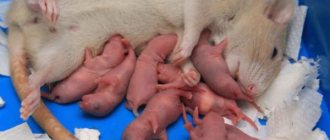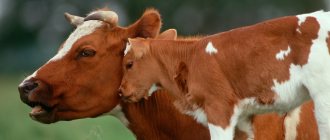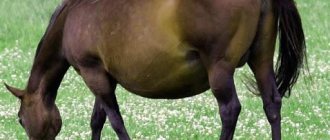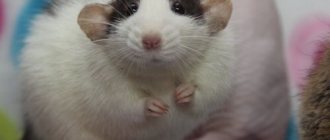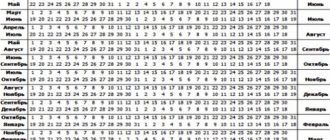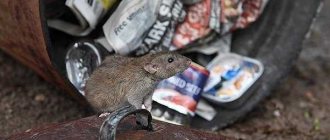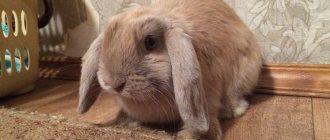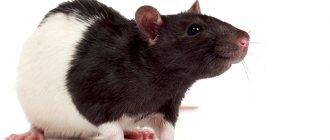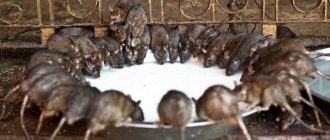Decorative mice should be kept in same-sex pairs or herds. If you combine a male and a female, after a while the surprised owner may find offspring in the cage.
Some people deliberately want to see newborn rat pups, watch their growth, and then leave someone for permanent residence. Such owners need to know everything about the birth of rats.
Harbingers of childbirth
Pregnancy in rats lasts on average 3 weeks, sometimes 20 days, which is rare, sometimes 24 days, quite often. Some animals bear offspring even longer - up to 28 days. It is difficult for the owner to determine the exact date of conception, but he can accurately determine the approaching birth of his pet by some clear signs - these are:
- behavior change;
- nest building;
- discharge from the genitals.
Behavior change
If a mouse lives in a shared cage with other siblings, 95 times out of 100 it will become aggressive: it will attack yesterday's friends for no reason, bite them until they bleed, and cut their skin. During such clashes, someone, a rival or an expectant mother, may get hurt. Sometimes a bite, seemingly insignificant at first glance, ends in the death of the animal: due to damage to a large artery, it bleeds in a matter of minutes, and nothing can be done to help.
The owner who consciously approaches the mouse offspring will provide peace to the pregnant female throughout the entire gestation period, which means she will live in a separate cage.
Animals mated to a male do not always fight with him. Although this is also not uncommon and is considered quite normal behavior, the female should calmly prepare for childbirth, but there is a representative of the opposite sex on her territory. But in such a situation, most often the mouse about to give birth behaves calmly: sleeps, eats, washes, plays with its cage neighbor. This happens exactly until time X comes.
In a note. Most males show aggression towards newborn rat pups, and when the mother leaves the nest, they eat them with pleasure. Never keep heterosexual animals together if the female is pregnant.
Nest construction
This is the next sign of the approaching birth. The female begins to build a nest shortly before the birth of the offspring. But here everything is individual. There are individuals that carry litter from place to place, carrying various rags found while walking around the cage, several days before giving birth.
Offer the female soft toilet paper or napkins for the nest. This is the best building material. In addition, it breaks easily, shrinks or swells, and does not have solid inclusions.
Newborn rats:
- he will not suffocate or be crushed: napkins or paper allow air to pass through and weigh nothing, even if they are folded on top of children;
- does not get tangled with threads and will not die from suffocation (less often than a rag);
- their noses do not become clogged with filler (if wood pellets are used - the cheapest and least suitable material for mice and their descendants to repair the floor in the house).
In a note. The day before birth, transfer the mouse to toilet paper or a special paper litter.
Discharge from the genitals
Appears shortly before birth. If they are noticed earlier, we can talk about a pathological pregnancy, which with a 90% probability will end in the death of the animal if it is not shown to a veterinarian. Normally, a female expecting offspring does not have any discharge from the genitals.
If blood stains are visible on plastic items or litter in the cage, the rat sits in a crumpled corner, is inactive, does not respond well to stimuli, and this condition lasts 2 or more hours, call a veterinarian or bring your own. He will perform a caesarean section, which will save the woman's life. He will remain a pet, but will no longer be able to have children.
Puberty and mating
On average, the lifespan of a decorative rat is 2.5-3 years. In such a short period of time, the animal must have time to give birth to offspring. Therefore, puberty in rats begins very early. In males - at 5 weeks, in females - at 6 weeks.
However, at such an early age it is better to avoid pregnancy. Because for a young, fragile female body this is a very heavy load, which can lead to adverse health consequences, including the death of the animal.
Too late first birth is also undesirable, since the offspring may be born weak and sick. The optimal age for reproductive function is 6-8 months.
Upon reaching the age of 5-6 weeks, males must be removed. Otherwise, upon the onset of puberty, they will immediately begin mating with all their cagemates, even with blood relatives.
How to tell if a rat is pregnant
Often, rat owners find out that their pet is pregnant on the day of birth, and in a state of shock they do not know what to do. True signs signaling an interesting position of the female will help you avoid such troubles:
- No heat . Normally, it occurs in the female once every 5 days and lasts 12 hours. During this period, the baby arches, lifts her muzzle, shaking her ears. And the loop increases, becomes moist and slightly open.
- Changes in behavior . Pregnant rats often display uncharacteristic aggression towards their cagemates. Active animals can switch to a measured lifestyle. But calm people, on the contrary, fuss and show anxiety.
- Changing taste preferences . While carrying pups, females switch to more nutritious food - meat, nuts, seeds, grains. And they may completely refuse their favorite light treats (fruits, vegetables, wooden sticks).
- Active weight gain . At the initial stages, you might think that the animal simply gained weight due to good nutrition. However, by the end of the 2nd week, you will notice a greatly grown belly against the background of a thin muzzle and upper body.
- Nesting . Closer to giving birth, the rat begins to arrange a future home for the rat pups. She begins to drag rags, pieces of paper, hay - everything soft and warm - to the chosen place.
A couple of days before the expected date of birth, you need to remove the filler from the cage, which is dangerous for the baby rats. Its small granules can enter the respiratory tract of babies and cause suffocation.
It is better to replace the filler with regular toilet paper. It is completely safe for offspring, hypoallergenic, breaks well, and retains heat.
Unique Fertility
In the Russian Federation the following types are most often found:
- Gray or pasyuk;
- Black;
- Turkestan (red).
Pasyuk Black rat Turkestan rat
One can only wonder why nature awarded rats with such amazingly productive fertility. They live and breed all over the world, not paying attention to either cold or hot climates, and their activity lasts all round. And only unforeseen natural disasters or any mass diseases can temporarily reduce their numbers.
Scientists believe that it was humans who contributed to changes in the behavior and survival of rats. Living next to a person, eating the products that he produces, these rodents live freely and comfortably. After all, food is always available, and all the traps prepared by people can be avoided. And if one rat was poisoned, the others will no longer approach such food. These animals have a fairly high intelligence. It is assumed that they have the makings of abstract thinking, which helps them navigate and stay alive in an unfamiliar place. All these skills are adopted by subsequent generations.
And considering how rats reproduce, all that remains is to start fighting them in time, because their activity in this case can take on catastrophic proportions.
Caring for a pregnant rat
During pregnancy, females are especially vulnerable. Not only their physiological state changes, but also their psychological state. Therefore, for the normal course of pregnancy, it will be necessary to provide the expectant mother with proper care.
Content
To ensure the rat's comfort, the following measures will need to be taken immediately after pregnancy is detected:
- Move the pet into a small cage, inside which there should be no play complexes, labyrinths, or running wheels. All interior items (house, drinking bowls, feeders) must be firmly secured.
- It is better to replace the usual filler with paper napkins or toilet paper.
- Move the cage to a remote room where the animal can hide from prying eyes and feel safe. At the same time, you need to take care of the microclimate in the room - it should be warm and dry inside, and you should also protect the fluffy from direct sunlight.
- The cage will need to be cleaned twice a week. During hygiene measures, the pet will have to walk around the room. It is not recommended to use detergents to wash the cage itself and everything in it. Safe baking soda will do the job perfectly.
After determining the rat’s permanent place of residence during pregnancy, under no circumstances should the cage be moved to another room or even to another place. Constant moving will cause discomfort to the animal.
Feeding
The diet of a pregnant rat is noticeably different from the menu of other pets. After all, the expectant mother needs a lot of energy and building material to carry rat pups normally. Therefore, nutrition for a pregnant female must be organized taking into account the following features:
- The basis of the diet, as before, should be grain. It is necessary to choose grain crops for feeding taking into account the preferences of the pet.
- As a source of protein, you need to give the rat more animal products - offal, lean meat, chicken cartilage, fish, shrimp, fermented milk products - low-fat cottage cheese, kefir.
- During the period of bearing babies, the rat needs more vitamins. Therefore, her menu needs to include a sufficient amount of fresh vegetables (zucchini, pumpkin, broccoli) and fruits (apple, banana, pear).
- During pregnancy, rodents often experience gastrointestinal disorders. To avoid digestive problems, you need to give your fluffy more fiber. Its natural sources are fresh grass (dandelion, plantain, fodder lettuce, parsley, dill).
Also, for a good metabolism, a pregnant female needs a large amount of fluid. Therefore, fresh water should always be available in drinking bowls.
The following foods are strictly contraindicated for pregnant rats: bell peppers, egg yolks, sour tomatoes, white cabbage, radishes, grapes, fresh milk.
Artificial feeding
In some cases, when the female dies after giving birth or refuses to breastfeed, you can try to feed the cubs to the child's family. Insulin syringes are used for this. Infant formula is taken in the proportion of 1 part to 50 ml of condensed milk with a high fat content of up to 12%, including half a tablet of calcium gluconate. It is acceptable to use milk replacers for cats or dogs.
Feeding should be done frequently with gradually increasing portions. It is preferable to give such cubs to another lactating female if she accepts them.
In conclusion, it should be said that breeding rats is quite a fascinating process, but do not forget that by crossing different species you can create something completely unusual.
Rat breeding
Decorative species of rats reproduce well at home. However, to obtain healthy, viable offspring, it is necessary to have at least basic knowledge about the biological characteristics of pets, the rules of feeding and keeping pregnant females and cubs.
Very often, only one animal is kept in the house as a four-legged friend and, even when having a couple of animals, as a rule, they do not set themselves the task of breeding them. Nevertheless, not only children, but also adults love to observe the life of rats, the birth and raising of offspring.
At home, white and colored varieties of rats are able to reproduce all year round.
However, breeding these animals in captivity requires certain conditions, although it does not present any particular difficulties.
Breeding new breeds of rats can be quite an exciting hobby. As a result of selection, it was possible to obtain numerous breeds and varieties of rats, therefore, when mating animals, this circumstance should be taken into account in order to preserve the breed or independently create a new variety of these animals.
The owner of a rat who decides to have offspring from it must understand that his decision is quite serious. First of all, he needs to think carefully about where the future babies will be placed. The health status of the rat is important: it should not suffer from mycoplasma and many other diseases.
You should prepare in advance for the appearance of numerous offspring, which may consist of 10-17 babies. Naturally, few people plan to keep so many rapidly maturing rats in their home. Thus, it is necessary to either take care of their new home in advance, or give it to a pet store, taking into account that most of the animals are used as food for reptiles.
In general, rats reproduce very easily, but it should be remembered that in their environment there is usually such a thing as inbreeding. Thus, based on this, upon reaching sexual maturity of animals, that is, in the 5th week of life, females are separated from males from the same litter - brothers and sisters, as well as mothers from sons.
A great effect in breeding new species and breeds of rats can be achieved by paying attention to one of the main characteristics. But unfortunately, this can lead to a deterioration to a greater or lesser extent of other qualities. Therefore, you should stick to the golden mean, improving all the positive signs.
Most often, animals of the same breed are mated; this method is called “pure breeding.” It allows you to improve animals according to basic characteristics: color, length and density of fur, size, etc.
One of the forms of purebred breeding of decorative rats is breeding along lines and family groups. A line in this case is a group of animals that has a common ancestor male, and the successors of the line are the descendant males. For successful reproduction of animals along the line, males are selected with appropriate females similar to them in basic decorative or useful characteristics.
When creating a family group, both males and females are considered carriers of the main characteristics. This method allows you to quickly improve the line.
If it is decided to create a new variety, then animals of different breeds or lines are crossed. To do this, an individual with characteristic qualities is selected and mated with an animal that has similar necessary qualities, and the offspring with the appropriate characteristics are crossed again with the founder of the breed. This method of reproduction is called absorption crossing.
Mating of close relatives is called inbreeding. Rats mate quite easily in various combinations: females and males of the same litter, descendants of the same male, etc., with the only exception being a pair of mother and son - they do not always begin to reproduce. Inbreeding is often used to create a pure line and enhance the outstanding qualities of sires in the offspring. However, with prolonged inbreeding, the offspring become less viable and ugly, since, as scientists believe, recessive genes appear in them.
Breeding rats for sale requires a large room, since it is impossible to keep a significant number of animals in a living room due to the specific smell of animals.
Moderate inbreeding with quick results at home can be achieved by matching one male with two females with the necessary qualities. To strengthen and consolidate the characteristics selected to create a new species, the best animals from one female are mated with the litter from another female or with their parents, and the young animals of the third litter are mated with the founders of the breed.
Share on the page
Next chapter >
It is important for those who keep rats to know everything about them.
How long does pregnancy last
To thoroughly prepare for childbirth, you need to calculate the approximate date of the exciting event. On average, a rat's pregnancy lasts 3 weeks from the moment of fertilization. However, the timing may vary depending on the number of babies.
Rats carrying 6-7 pups can give birth earlier - on the 19-20th day. And if 17-20 rat pups are planning to be born, delivery may be delayed until 22-23 days. Carrying offspring for more than 24 days is a reason to contact a veterinarian. Prolonged pregnancy in rats often signals problems.
Possible problems and complications
Typically, rats cope with labor on their own and do not require additional assistance. However, no one is immune from possible complications. The following signs indicate problems:
- bloody or purulent vaginal discharge;
- complete absence of movement when palpating the abdomen before childbirth;
- animal apathy, refusal of food and water;
- prolonged labor – longer than 5 hours;
- the female gave birth to several babies, but does not show attention to them - probably several more rat pups got stuck passing through the birth canal.
If you detect at least one of the listed signs, you must immediately take your pet to the veterinary clinic. Surgical intervention may be required to save the rat.
Sometimes rat pups are born in the amniotic sac, and the weakened mother is not able to free the newborns on her own. In such a situation, you should not waste time going to the veterinarian - you can help the furries yourself. To do this you need:
- clean your hands with alcohol;
- wrap the index finger and thumb with a sterile bandage;
- gently pick up the baby in the shell with bandaged fingers;
- with the other hand, cut the amniotic sac using nail scissors and release the baby rat;
- use gauze to remove accumulated mucus from the baby’s mouth and nose.
If all manipulations are carried out correctly, the little rat should squeak. You will also need to cut the umbilical cord and treat the wound with chlorhexidine.
Types of breeding
In domestic rats, two types of crossbreeding are possible: selection of different breeds and purebred breeding.
In turn, purebred crossing is divided into the following types:
- Linear crossing;
- Inbreeding;
- Outcrossing;
- Outbreeding.
Linebreeding
Linebreeding or line breeding of rats involves crossing individuals that have a common ancestor. This method allows you to obtain viable offspring with a good genotype. In this case, homozygosity is preserved, and characteristics that do not satisfy the breeder are leveled out.
Inbreeding
To consolidate important breed qualities, the inbreeding method is chosen. Breeding rats in this way involves studying the gene pool and selecting quality sires among close relatives. With close inbreeding, a decrease in the number of viable offspring is possible - so-called inbreeding depression. To reduce the risk of such a situation, individuals for breeding are selected according to strict criteria.
Outcrossing
Outcrossing is used when it is necessary to increase the number of litters with valuable qualities. Mating uses individuals obtained by linebreeding, but without common ancestors in the fourth or fifth generation. To improve the breed, young animals that are unsuitable for a good genetic line are removed from the litter.
Outbreeding
To improve the quality of the breed and the health of the litter, outbreeding is the best option. With such crossing, individuals of a pure breed are selected, but without common ancestors. The disadvantage of this method of breeding is that there is a risk of unplanned characteristics and with frequent use, after several generations the proportions of the animal change.
Despite the different selection options that can be combined, there is still an unpredictable result. This is manifested in the color and length of the coat, the number of individuals in one litter, eye color, and level of health.
Preparing for childbirth
Childbirth is a complex and responsible process, so you need to carefully prepare for the birth of babies. The only thing the owner can do to help a rat during delivery is to create comfortable conditions. To do this you need:
- curtain the windows, creating twilight in the room; you can also shade the cage using cardboard;
- eliminate even the slightest draft in the room;
- take care of a comfortable air temperature of +20-21ᵒС;
- Provide the cage with plenty of paper and fill the drinking bowls with water.
To prevent the rat from becoming nervous during childbirth, you should not stand over the cage and observe this intimate process. It's better to leave the room for a couple of hours. The pet itself will cope perfectly with the birth of babies.
Factors affecting reproduction
In the wild, the number of times a rat gives birth per year is influenced by climatic conditions, availability of food in the right quantities, natural disasters, and environmental conditions. We must not forget that natural selection allows only strong cubs to survive.
At home, despite the fact that rats are not so dependent on external factors, breeders try to limit the number of pregnancies, since frequent births affect the health of pets.
The birth of healthy rat pups and their number are influenced by the air temperature in the apartment, humidity, balanced nutrition, and stressful situations. Genetic factors also play a role. Spontaneous mutations and hidden recessions may occur.
Birth of baby rats
On average, birth in rats lasts 2-3 hours. Before the onset of labor, a mucous plug emerges from the genital tract, which throughout the pregnancy protected the offspring from infection. During childbirth, the rat sits down on its hind legs and helps the pups to be born. The interval between the birth of cubs is 5-7 minutes.
The female independently gnaws the umbilical cord and carefully licks the born rat pups. Quick movements with a warm tongue stimulate blood circulation and help open the lungs. After completing hygiene procedures, the new mother gathers her newborn babies into a pile and begins breastfeeding.
A rat has only 12 nipples, and the cubs often have 14-16. Therefore, rodents practice alternate feeding of rat pups, which is impossible with insufficient lactation.
If a newborn rat does not move, does not squeak, and does not show any signs of life, the rat simply eats it.
Caring for the rat and offspring
After giving birth, the mother rat actively protects the offspring, so in no case should you touch the rat pups with your hands. Otherwise, at best, she will bite the owner, at worst, she will eat the offspring on which the foreign smell remains.
It is recommended to carry out the first general cleaning inside the cage only after the babies open their eyes. This usually happens on days 13-15. Before this, it is recommended to gradually change the paper. Contaminated pieces are replaced with fresh ones using a regular spoon.
You also need to take care of good nutrition for the nursing mother. She should receive more meat products, fresh fruits, vegetables and herbs, nuts, and grains. Adequate nutrition will ensure good milk production.
At 5 weeks, babies can be separated from the rat. Especially boys, since at this age they have already reached puberty, and will definitely try to impregnate their mother. And the animal may simply not be able to withstand a quick repeat birth. This article will help determine the sex of the rat pups.
Pregnancy and childbirth in rats are relatively favorable and painless. But only on condition that at least 3-4 months pass between gestations. Then the pet will again be able to please its owner with a new addition to the family.
Wild conditions
The mating season for rats begins in the spring, both domestic and wild, i.e. Everyone has the same time to produce offspring. However, there are further differences.
In nature, the reproduction rate of rats is low. They mate only in spring and summer. This happens due to living conditions. If the region in which the population is located is cold and wet, mating rarely occurs. Usually this can be in the Far North, taiga, jungle, and so on. The opposite situation occurs if rodents live in a warm climate.
During mating, the male hunts for several females at once, after which each becomes pregnant in turn. The pregnancy itself lasts only a month, sometimes less. Before giving birth, the female arranges a nest for the future offspring: she collects straw, leaves, branches, digs a hole and lays out the collected materials there. Then he brings food there, the reserves of which should be enough for the first weeks of the little rats’ lives. Usually about ten or fifteen babies are born at a time.
The cubs themselves are born completely naked, blind and incapacitated. Many functions of their body do not work, for example, digestive, which is why the mother licks their bellies so that all metabolic processes are normalized. But a little time passes, the pups grow fur, after seven days their eyes and ears open, after another week their teeth erupt, and towards the end of the month they can already move around calmly on their own. By this time, the pups turn into real adult rats and are able to live independently, separately from their parents, but they reach the size of an adult only after a year.
Puberty in adult rats occurs when the processes of growth of the body and organism have not yet been completed. In fact, at the age of several months, a rat can reproduce peacefully.
